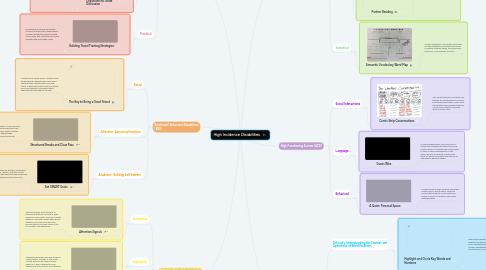
1. Speech-Language Impairments (SLI)
1.1. Articulation
1.1.1. Repetition, Visual Modeling, Sounding Out and Overexaggerated Speech
1.1.1.1. Repetition, visual modeling, sounding out, and overexaggerated speech helps students to form correct letter sounds and more precise articulation skills
1.2. Fluency
1.2.1. Partner Reading
1.2.1.1. Partner reading allows students to guide one another's reading. To build fluency and close the gap, partner students with high and low achieving fluency.
1.3. Semantics
1.3.1. Semantic Vocabulary Word Map
1.3.1.1. Graphic organizers a vocabulary word map will help students build meaning of words by having students define, find synonyms, antonyms, and formulate a picture.
2. High Functioning Autism (ASD)
2.1. Social Interactions
2.1.1. Comic Strip Conversations
2.1.1.1. This allows students to visualize and prepare for conversations and social interactions with others. Comic strip conversations also prepare students for the many variations possible about a certain topic.
2.2. Language
2.2.1. Guess Who
2.2.1.1. To build language skills, find out topics or people that students are interested in and create games or activities that require them to work on their language skills. In the video, the girls are playing a Guess Who game of familiar individuals and thinking of new ways to describe others.
2.3. Behavioral
2.3.1. A Quiet, Personal Space
2.3.1.1. Students need a quiet, personal space that allows them to feel at home. These are spaces that students can decorate and places to focus on academic and career readiness tasks.
3. Specific Learning Disabilities (SLD)-- Dyscalculia
3.1. Difficulty Understanding the Context and Operations of Word Problems
3.1.1. Highlight and Circle Key Words and Numbers
3.1.1.1. When working with word problems, have students use the BUCKS strategy. The BUCKS strategy helps students work step by step, highlighting and circling key words and numbers, to solve word problems.
3.2. Remembering Basic Math Facts
3.2.1. Provide tables or charts of math facts
3.2.1.1. This video provides many strategies for multiplication facts using the multiplication table. This serves as a good tool to guide students to automaticy.
3.3. Weak Mental Arithmetic Skills
3.3.1. Provide step-by-step instructions and have the student repeat them.
3.3.1.1. A foldable is a good personal tool to document and reference step-by-step instruction. This foldable shows the steps of the order of operations and some examples.
4. Intellectual Disabilities (ID)
4.1. Conceptual
4.1.1. A Classroom Economy
4.1.1.1. In a classroom economy students are able to work on skills they will need outside of school. Such as the application and hiring process, having a job, money skills, and the ability to shop or save
4.2. Social
4.2.1. Literature and Graphic Organizers to Guide Discussion
4.2.1.1. Literature provides stories, experiences, and opportunities for students to complete a graphic organizer and discuss various topics in small groups. In the video, students are discussing and completing a graphic organizer about the character's emotions in the story.
4.3. Practical
4.3.1. Building Travel Training Strategies
4.3.1.1. Building travel training skills allows students to have more independency. Teachers are able to address routing skills, safety, and commute skills using Google Earth and Google Maps.
5. Emotional/ Behavioral Disabilities (EBD)
5.1. Social
5.1.1. The Key to Being a Good Friend
5.1.1.1. In order to be a good friend, students must understand the characteristics of a good friend and the characteristics of a bad friend. Creating an anchor chart or a poster will allow students to reference these characteristics throughout the year.
5.2. Affective- Assessing Emotions
5.2.1. Structured Breaks and Class Pass
5.2.1.1. Providing structured breaks or class pass acts as both a reward and consciousness of their own mental health. This self assess strategy allows students time to address their internalized emotions before becoming externalized,
5.3. Academic- Building Self-Esteem
5.3.1. Set SMART Goals
5.3.1.1. SMART goals are specific, measurable, attainable, realistic, and time-bound. Students who set goals take more pride in their learning and build their self esteem.
6. Attention Deficit Hyperactivity Disorder (ADHD)
6.1. Inattention
6.1.1. Attention Signals
6.1.1.1. Attention signals allow teachers to incorporate physical movement, build classroom community, and gain students attention. The video shows whole group attention, but some more personal, discrete options includes sticky notes, eye contact, and whispering.
6.2. Impulsivity
6.2.1. Coping Skills
6.2.1.1. Learning coping skills can help students contain stress, feelings, or impulsivity. Coping skills include taking a break, going for a walk, listening to music, physical exercise, writing, and breathing.
6.3. Hyperactivity
6.3.1. Stress Balls/Fidget Toys
6.3.1.1. Stress balls or fidget toys are therapeutic devices for students to increase concentration. This tool gives student's bodies something to do while they focus on a task. These are good forms of rewards.
